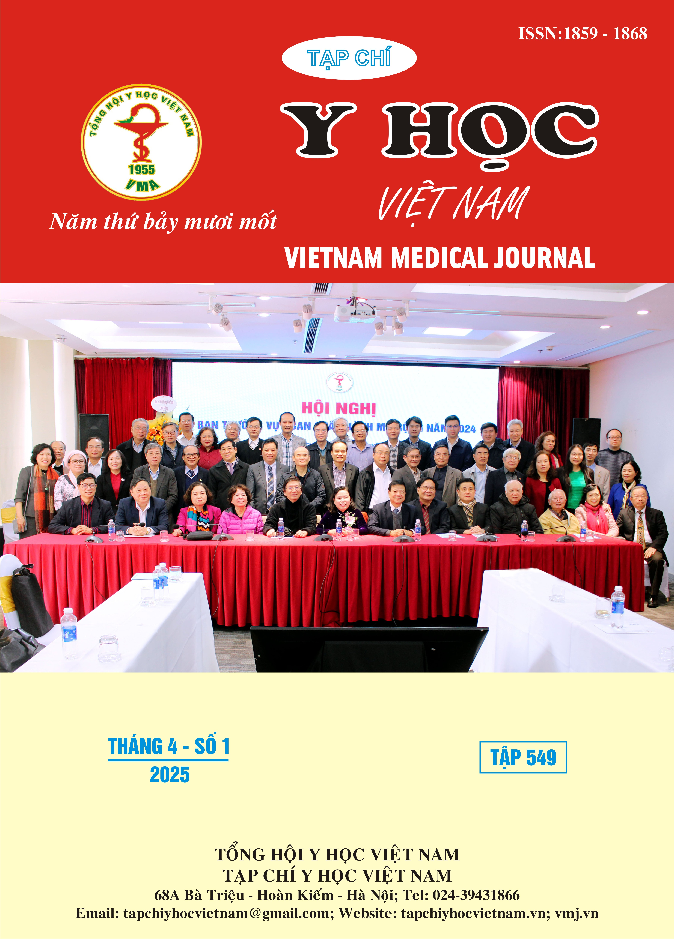REFERENCE VALUES AND SOME FACTORS AFFECTING PHRENIC NERVE CONDUCTION STUDY IN ALDULTS AT VIETDUC UNIVERSITY HOSPITAL
Main Article Content
Abstract
Phrenic nerve conduction study directly assesses phrenic nerve function. Due to the specificity of phrenic nerve anatomy, respiratory physiology, and diaphragm position, there are still many limitations in phrenic nerve conduction study as well as interpretation of results.. Objectives: Describe the characteristics of phrenic nerve conduction and some factors affecting. Methods: Cross-sectional descriptive study in adult volunteers at VietDuc University Hospital from March 2024 to March 2025. Results: The motor response amplitude during insoiration (min/max/mean ± SD) 0.4/1.22/0.8 ± 0.2 mV, p<0.05. The maximum latency during inhalation 7.95 ms. BMI was correlated with stimulation intensity, linear correlation equation: Stimulation amplitude = 0.846 * BMI – 4.513, r=0.64, p< 0.001. Height factor, distance from stimulation to recording may be related to phrenic nerve latency time, p< 0.05. Conclusion: The amplitude of phrenic nerve response differs during inspiration and expiration. BMI correlates with stimulation amplitude, and latency may be influenced by height.
Article Details
Keywords
phrenic nerve, nerve conduction study
References
2. D. Shah, S. Vernino, and S. Khan, “Value of Diaphragm Electromyography and Phrenic Nerve Conduction Studies in Suspected Diaphragm Paresis (P5-13.005),” Neurology, vol. 98, no. 18_supplement, p. 634, May 2022, doi: 10.1212/WNL.98.18_supplement.634.
3. V. Reynaud, H. Prigent, A. Mulliez, M.-C. Durand, and F. Lofaso, “Phrenic nerve conduction study to diagnose unilateral diaphragmatic paralysis,” Muscle Nerve, vol. 63, no. 3, pp. 327–335, Mar. 2021, doi: 10.1002/mus.27144.
4. D. S. Gierada, R. M. Slone, and M. J. Fleishman, “Imaging evaluation of the diaphragm,” Chest Surg. Clin. N. Am., vol. 8, no. 2, pp. 237–280, May 1998.
5. A. Resman-Gaspersc and S. Podnar, “Phrenic nerve conduction studies: technical aspects and normative data,” Muscle Nerve, vol. 37, no. 1, pp. 36–41, Jan. 2008, doi: 10.1002/mus.20887.
6. A. A. Maranhão, S. R. da S. Carvalho, M. R. Caetano, A. H. Alamy, E. M. Peixoto, and P. D. E. P. Filgueiras, “Phrenic nerve conduction studies: normative data and technical aspects,” Arq. Neuropsiquiatr., vol. 75, no. 12, pp. 869–874, Dec. 2017, doi: 10.1590/0004-282X20170153.
7. C. Morélot-Panzini, E. Fournier, C. Donzel-Raynaud, O. Dubourg, J.-C. Willer, and T. Similowski, “Conduction velocity of the human phrenic nerve in the neck,” J. Electromyogr. Kinesiol. Off. J. Int. Soc. Electrophysiol. Kinesiol., vol. 19, no. 1, pp. 122–130, Feb. 2009, doi: 10.1016/j.jelekin.2007.06.017.
8. David C. Preston, Electromyography and Neuromuscular Disorders. in Third Edition. Elsevier, 2013.


